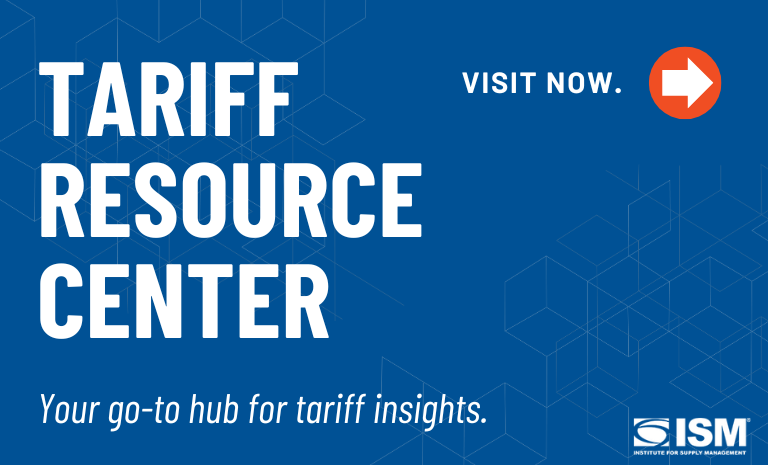Supply Chain Roundtable: A Railway Merger, Peak-Season Prep and a Toast to Workers

With Labor Day — or Labour Day, for Canadian and Australian readers whose nations will also celebrate — next week, workforces across industries will enjoys a long weekend in their honor, and the supply chain profession is no less worthy of extra relaxation.
As an appreciation, the monthly roundtable of experts from Institute for Supply Management® (ISM®) offers its performance review of supply chain employees, from purchasing executives to logistics specialists to skilled trade workers who build and fix things. The reviews, particularly for resilience and adaptability, are deservedly glowing.
Along the way, the panelists — Thomas W. Derry, ISM CEO; Jim Fleming, CPSM, CPSD, Manager, Product Development and Innovation; Paul Archiopoli, C.P.M., CPSD, CPIM, CMFGE, Subject Matter Expert; and Michelle Rohlwing, MBA, Manager, Product Development, Innovation and Learning — discuss recent supply chain issues, including a potentially historic railway merger and holiday peak-season preparations.
Q: Amid the announced merger between Union Pacific and Norfolk Southern, companies are no doubt using their M&A playbooks. But are there unique opportunities and risks to this somewhat unprecedented — it would create the first fully integrated coast-to-coast freight railroad in U.S. history — merger?
Derry: The merger will get antitrust scrutiny. The companies are making the argument that customers will get better service, they’ll be more efficient and potentially lower costs. But they’ll be a monopoly. That’s not illegal per se; it’s a matter of how you use your monopoly power. So, it’s not going to be a layup with regulators, and the unions will have a say. For certain complex pieces of machinery, rail freight is the only game in town. During the pandemic, there was major congestion in the Chicago area, where you have to switch networks. I’d be curious to see if that actually improves. We’ve been in a trucking recession, and a lot of cargo has been rerouted from the Pacific coast ports to alternative ports. The big picture here is that demand for freight and transportation is constantly shifting, and it’s a very volatile market. The biggest advice I would have for someone who is moving a lot of materials by rail is to just pay attention.
Archiopoli: There are a lot of moving pieces in this situation, but putting aside the regulatory approval component, there are unique opportunities driven by the proposed merger: (1) faster transit times due to reduced hand offs and delays, (2) the potential to greatly increase intermodal offerings and (3) expanded routing options for chemicals, agricultural products and other goods. Additionally, there will be significant operational synergies in a combined company; these include revenue growth potential due to reduced competition — potentially more than US$1 billion annually — and a reduction of redundancies in systems and personnel.
Fleming: While M&As are always intending to bring more value, only time will tell. This merger is intending to streamline operational efficiencies, lower corporate costs, leverage technology advancements and reduce transit times. But the downsides include antitrust scrutiny, job losses and integration disruptions. All M&As have a balancing act for pros and cons, and this is no different. While the pros and cons may be similar, the fact that the merger could impact a supply chain will likely make the cons more newsworthy, given the increased public awareness and sensitivity to supply chain issues.
Rohlwing: This merger does sound like it could a game-changer, creating the first coast-to-coast freight railroad in U.S. history. While it promises more efficiency by eliminating handoffs at bottlenecks like Chicago and Memphis, it also raises serious concerns around competition, labor and regulations. This would concentrate about 90 percent of rail freight among only four carriers. Unions are warning of staffing cuts and safety concerns. There could also be some antitrust issues to resolve.
Q: Companies are — or they should be — well into their holiday peak-season purchasing and logistics plans. Is that process more challenging this year due to tariffs?
Fleming: From a pure economics situation, the supply and demand will create a challenging environment. Supply chains are a direct function of customer demand for products. Tariffs on consumer goods manufactured in foreign countries, such as televisions, smartphones, computers and automobiles could strain general holiday shopping. Consumer wallets are already being tested with interest rates, unemployment rates and other economic stressors. Holiday shopping could be significantly impacted. This is a time for supply chain professionals to get further engaged with their company’s sales and operations planning (S&OP) processes. Product demand and forecast signals are going to be critical to optimize the entire supply chain. It could make the difference between a company making a profit or suffering a loss.
Archiopoli: Frankly, my perspective is that the tariff panic is overblown. There are annoyances and industries need to make adjustments but, for the most part, the tariff situation is an imaginary problem given oxygen by the press, politicians and pundits.
Rohlwing: Tariffs could make this year’s holiday season more complex, especially for those sourcing from China. Some tariffs are up to 145 percent. Many companies are looking to move production to other countries, specifically Vietnam or Mexico, but scalability can be an issue. I’m hearing of some companies using artificial intelligence (AI) tools and diversification to stay ahead of the game.
Derry: Tariffs, of course, are paid when the product hits the shores of the importing country. For capital goods that have like 52-week or even longer lead times, those orders were placed long before tariffs were even mentioned. So, for some of these retail products, what allowance was made for tariffs? And if a company is in the ballpark at least, it’s probably not a problem. Right now, however, there are plenty of signs that consumers are feeling pinched. How will that impact sales for the holiday season? I don’t anticipate logistics problems, and if an importing company estimated the impact of tariffs within a reasonable range, then it probably did a good job of planning.
Q: What’s the one outdated supply chain belief you think leaders need to let go of?
Rohlwing: I think the strategy of “just-in-time is always best” needs to be let go of in these volatile times. As a previous manager of mine used to say, “It always depends on the scenario.” With the coronavirus pandemic and geopolitical issues, sometimes a resilient and flexible supply chain can matter more than efficiency.
Derry: There was an era from 1995 to 2015, I would say, when supply chains were driven with only one idea, which is total lowest cost. That’s outdated now because of the need for resiliency and to manage risk and disruption. The pandemic and geopolitics have exposed our country’s national- and economic-security vulnerabilities. And CEOs can’t take for granted assurance of supply — which brings into play this idea of being at risk of losing market share to competitors or foregoing sales. So, the idea that you can focus exclusively on lowest cost and build a high-performing supply chain is outdated.
Archiopoli: We need to rethink the assumption that global sourcing is always cheaper. This venerated belief is being challenged on several levels, including from political instability in “source” countries, freight cost and capacity volatility, rapid advances in manufacturing automation, and the re-emergence of vertical integration.
Fleming: The belief that supply chains are only a cost reduction organization. Modern supply chains also drive revenue within corporations. Whether it is revenue preservation due to risk management or revenue generation with supplier relationship management initiatives (like early supplier involvement, supplier innovation, and sustainability), supply management has expanded the focus on a corporation’s profit-and-loss statement. Engaging earlier in new product development, supply management and suppliers are shortening time to market. Working closer with product development teams, new designs and materials can be delivered in a shortened time horizon. This reduction in product launch time equates to increased revenue within compressed release window.
Q: With Labor Day approaching, what has impressed you most about the supply chain workforce?
Archiopoli: Resilience and adaptability. The supply chain workforce continues to demonstrate remarkable amounts of both — swiftly responding to disruptions, embracing innovation and sustaining operations through evolving global challenges and technological shifts.
Fleming: Similar to Paul’s response, one word: resilience. Merriam-Webster defines it as “ the ability of an elastic material (such as rubber or animal tissue) to absorb energy (such as from a blow) and release that energy as it springs back to its original shape. The recovery that occurs in this phenomenon can be viewed as analogous to a person’s ability to bounce back after a jarring setback.” When I think of the supply chain workforce, it aligns with this. It has been a rough number of years within supply chain, yet the profession is viewed as a competitive advantage for the most successful companies in the world, including Amazon, Apple and Proctor & Gamble. The workforce is what enables success, whether through performing category management and sourcing strategies to integrating advanced technologies into the ecosystem. Supply chain professionals should all be proud of the difference they are making in the world.
Derry: Resiliency. We’ve moved very rapidly to adopt new technology and processes to make us better at our jobs. Another thing is the resurgence of appreciation for traditional trade skills: welders, electricians and the like. That’s good not only for supply chains but also because our country has been facing a critical shortage of people with those key skills. As a result, there’s been talk of more development of apprenticeship programs, and we’ve had some success there. But it will have to continue, because we need those skills if we’re going to reshore jobs. Building a new semiconductor fabrication plant requires very, very technical expertise.
Rohlwing: The ability to learn and learn quickly. With emerging technologies like AI, I think it’s impressive how some have adapted and researched in record time to use new tools to their advantage.

